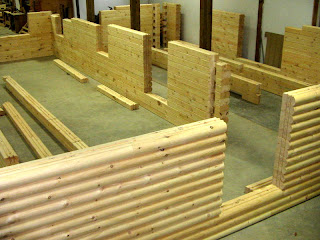
The Maintenance of a Log Home starts when you choose the log home producer!
The amount of maintenance you will have to do to your home, once constructed, is directly affected by the log home package you choose to build. It makes sense that the better built anything is, the less maintenance you will have to perform on it, and the longer the components will last before requiring fixing or replacing.
Yes. Log homes, as does any home, require maintenance. One would expect that. The exterior of a log home is wood that is exposed to the elements. No matter what species of wood, to keep it looking good requires routine applications of a wood preservative and water repellent to keep the wood from absorbing moisture and turning grey and black from oxidation and mildew that builds up in the cells of the wood. This is true for all wood species- either pre-treated or untreated.
Other maintenance however, such as the need for caulking, leveling of the logs and posts, and filling in any gaps that occur over time is directly affected by the quality of materials used and the preparation of the logs. These things can be minimized with a little TLC (a.k.a. Total Log Care here at Beaver Mountain) before the house is constructed.
The amount of maintenance you will have to do to your home, once constructed, is directly affected by the log home package you choose to build. It makes sense that the better built anything is, the less maintenance you will have to perform on it, and the longer the components will last before requiring fixing or replacing.
Yes. Log homes, as does any home, require maintenance. One would expect that. The exterior of a log home is wood that is exposed to the elements. No matter what species of wood, to keep it looking good requires routine applications of a wood preservative and water repellent to keep the wood from absorbing moisture and turning grey and black from oxidation and mildew that builds up in the cells of the wood. This is true for all wood species- either pre-treated or untreated.
Other maintenance however, such as the need for caulking, leveling of the logs and posts, and filling in any gaps that occur over time is directly affected by the quality of materials used and the preparation of the logs. These things can be minimized with a little TLC (a.k.a. Total Log Care here at Beaver Mountain) before the house is constructed.
A) Proper drying of the logs will stabilize them and minimize shrinking and twisting.
B) The grade of the logs will reflect the amount of checking, the slope of the grain and the size of the knots allowed in the logs and timbers as well as the structural integrity. The better the grade, the less chance of large checks occurring, knot fallout, and bowing and splitting of the logs.
C) Shaping the logs after the drying process will mill out many of the checks that occurred during the drying process.
D) The use of specialty tools to cut and cope the logs, and air tight joinery between the logs and at all joints is essential to minimize the maintenance on the home. Cuts done in the factory by specialized equipment and stationary saws are sure to be more accurate and air tight than those done by hand held saws or chainsaws in the field. Drilling lag bolt holes and making the log butt joint spline grooves in the factory will be more accurate than drilling dowel holes between the logs in the field.
All of these things directly affect the performance of you new home, the energy efficiency, and protect the value of your investment over time.
So ask questions, look closely at the details of construction, find out how the cuts are done, and become an informed shopper. Your home is a large investment. You want to enjoy it, not be a slave to it! Quality may cost more up front, but it helps protect your investment and will save you time and money in the future. - Joan Decker
All of these things directly affect the performance of you new home, the energy efficiency, and protect the value of your investment over time.
So ask questions, look closely at the details of construction, find out how the cuts are done, and become an informed shopper. Your home is a large investment. You want to enjoy it, not be a slave to it! Quality may cost more up front, but it helps protect your investment and will save you time and money in the future. - Joan Decker
Give us a call and schedule a Consultation Today! 1-800-233-2770



